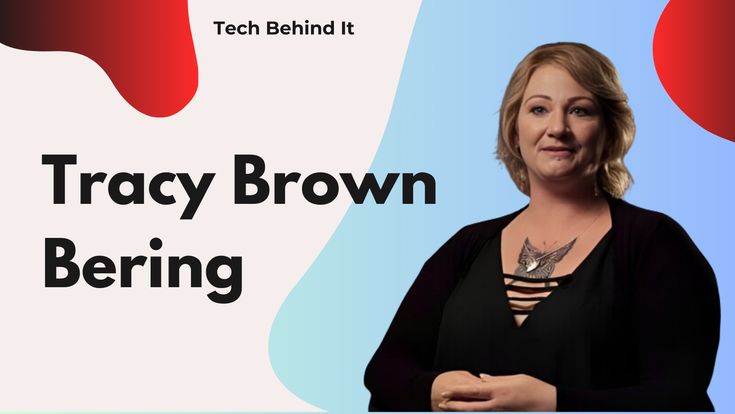In a world filled with social and economic disparities, the nonprofit sector plays a crucial role in bringing about positive change. However, many nonprofits struggle to secure funding, sustain their initiatives, and make a lasting impact. But what if there was someone who could revolutionize the way nonprofits operate and ensure their long-term success?
Tracy Brown Bering is a visionary leader who has dedicated her career to transforming the nonprofit sector. With a background in business and extensive experience in nonprofit management, she has developed innovative strategies to address the challenges faced by nonprofits and drive meaningful change.
Through her pioneering work, Tracy Brown Bering is revolutionizing the nonprofit sector by introducing new models of sustainability, creating collaborations, and implementing effective strategies for impact measurement. Her groundbreaking initiatives have already started to reshape the landscape of nonprofit organizations, offering hope and inspiration for the future. Let’s delve into Tracy’s remarkable journey and explore the transformative potential of her contributions to the nonprofit world.
Background of Tracy Brown Bering
As Tracy Brown Bering stood in the cluttered attic of her childhood home, she couldn’t help but feel a surge of nostalgia as old memories came flooding back. The dusty sunlight filtered through the cracked windows, casting a warm glow on forgotten trinkets and mementos from years gone by. Each item seemed to whisper a story, telling tales of joy and sorrow, success and failure. It was in this attic that Tracy’s passion for storytelling first took root, inspired by the enchanting books she unearthed from forgotten boxes.
Growing up amidst the bustling streets of New York City, Tracy developed an insatiable curiosity about the world around her. Her daily escapades through Central Park opened her eyes to nature’s intricate beauty juxtaposed against urban chaos, instilling within her a profound appreciation for life’s paradoxes. This duality has since colored Tracy’s writing style—a delicate balance between raw vulnerability and unyielding strength, much like the city that shaped her. Her words flow with the rhythm of subway trains hurtling beneath crowded sidewalks—resilient yet tender, a symphony of contrasts that captivates readers’ hearts and minds alike.
Her vision for the nonprofit sector
Tracy Brown Bering is a visionary leader who sees boundless potential in the nonprofit sector. Her vision revolves around creating an ecosystem of collaboration and innovation where nonprofits work together to amplify their impact. She believes in leveraging technology and data-driven decision making to drive operational efficiency and maximize social outcomes.
Furthermore, Tracy envisions a future where the nonprofit sector is seen as an equal player alongside the public and private sectors. She advocates for dynamic partnerships that foster cross-sectoral collaborations, bringing diverse stakeholders together to address complex societal challenges. Tracy’s approach centers on promoting transparency, accountability, and sustainability within the nonprofit space, ultimately striving for long-term systemic change rather than short-term fixes. This forward-thinking vision holds the promise of transforming how nonprofits operate and deliver value to their communities, paving the way for a more impactful and resilient social sector.
Challenges in the current nonprofit landscape
Tracy Brown Bering, a prominent figure in the nonprofit sector, has highlighted the pressing challenges facing organizations in today’s landscape. One major hurdle is the increasing competition for funding. With more nonprofits vying for limited resources, organizations are forced to become more innovative and strategic in their approach to securing financial support.
Additionally, there is a growing need for transparency and accountability as donors and supporters demand evidence of impact. Nonprofits must navigate complex reporting requirements while also demonstrating tangible results to maintain trust and attract continued investment. These challenges call for leaders like Tracy Brown Bering to advocate for smarter resource allocation and improved measurement techniques within the nonprofit space. Adapting to these changing dynamics is crucial for organizations seeking long-term sustainability and meaningful impact amidst an evolving philanthropic environment.
Innovations in Fundraising:
Innovations in fundraising have been transforming the way organizations raise capital, and one individual continuously making waves in this sphere is Tracy Brown Bering. Her innovative approaches to fundraising have incited major shifts in traditional methods. Bering’s utilization of technology has opened up new channels for connecting with potential donors. By leveraging social media, crowdfunding platforms, and virtual events, Bering has tapped into a wider audience and amplified the impact of her fundraising efforts.
Furthermore, Bering’s emphasis on storytelling as a tool for fundraising has redefined donor engagement. Instead of simply asking for donations, she crafts compelling narratives that resonate with supporters on an emotional level. This creates a personal connection between donors and the cause they are supporting, ultimately leading to increased long-term support. Additionally, through data-driven strategies, Bering effectively targets potential donors based on their interests and giving preferences, enhancing the efficiency of fundraising campaigns while maximizing their impact.
Tracy Brown Bering’s innovative approach to fundraising demonstrates that adaptability and creativity are crucial components in navigating the evolving landscape of philanthropy. With an emphasis on technological advancements and personalized storytelling techniques, these innovations hold significant promise for the future of fundraising initiatives across various sectors.
Utilizing technology for donor engagement
Utilizing technology for donor engagement has become a game-changer in the world of philanthropy. With the rise of social media, organizations now have an unprecedented opportunity to connect with donors on a deeper, more personal level. Take for instance the innovative approach by Tracy Brown Bering, who leverages virtual reality technology to create immersive experiences that transport donors directly into the heart of their cause. This not only fosters empathy and understanding but also encourages sustained involvement and support.
Furthermore, email marketing automation platforms like Mailchimp or Hubspot enable nonprofits to tailor personalized communication and fundraising campaigns based on donors’ preferences and behavior. By utilizing data analytics tools, organizations can gain valuable insights into donor demographics, engagement patterns, and giving trends. This information is instrumental in crafting targeted strategies that resonate with donors on a more individualized level—a crucial aspect in today’s highly competitive philanthropic landscape.
Embracing technology as a means of donor engagement proves essential in fostering meaningful connections and ultimately driving impactful change. The possibilities are vast, from interactive mobile apps that provide real-time updates on projects funded by donations to leveraging storytelling through virtual reality experiences—all designed to captivate potential donors and deepen their commitment to a cause they are passionate about. Tracy Brown Bering sets an inspiring precedent for tech-driven innovation in donor engagement—ushering in an exciting era where charitable giving becomes not just an act but truly an experience.
Addressing community needs through innovative programs
Tracy Brown Bering has been at the forefront of addressing community needs through innovative programs. Her groundbreaking initiatives have focused on providing holistic support to vulnerable populations, going beyond traditional services to meet the multifaceted needs of individuals and families. By leveraging a creative and forward-thinking approach, Tracy has successfully developed programs that not only fulfill immediate needs but also create sustainable, long-term impact within communities.
One of Tracy’s standout innovations is the implementation of integrated service models that bring together diverse organizations and resources to address complex social challenges comprehensively. Through collaborative partnerships and strategic resource allocation, she has spearheaded initiatives that effectively tackle issues such as poverty, homelessness, and access to healthcare. This approach not only maximizes the impact of each program but also fosters a sense of collective responsibility among stakeholders in meeting community needs.
Furthermore, Tracy’s emphasis on ongoing evaluation and adaptation has resulted in programs that remain responsive to changing community dynamics and emerging needs. By prioritizing data-driven decision-making and continuous feedback loops, she ensures that her innovative initiatives remain relevant and effective in addressing the evolving landscape of community requirements. Tracy Brown Bering commitment to pushing the boundaries of traditional service delivery models exemplifies her dedication to creating lasting change by meeting communities’ most pressing needs in transformative ways.
Leadership and Advocacy:
Leadership and advocacy are instrumental in driving meaningful change within communities and organizations. Tracy Brown, a prominent figure in the field of advocacy, emphasizes the importance of leading with empathy and authenticity. Effective leadership in advocacy requires a deep understanding of the issues at hand and a commitment to amplifying the voices of those who are often marginalized or overlooked.
Bering’s work in advocating for social justice highlights the power of using one’s platform to create positive change. True leadership in advocacy involves actively seeking out opportunities to advocate for others and using one’s influence to push for systemic change. By embodying these principles, leaders can inspire others to join the cause and work towards a more just and equitable society. Leadership within advocacy requires courage, resilience, and a willingness to challenge existing power structures in pursuit of progress.
Results and Success Stories:
Tracy Brown, a successful entrepreneur, has achieved remarkable results in her business venture, Bering. By employing innovative strategies and determination, Tracy has seen substantial growth and success with Bering. Her ability to navigate through challenges and adapt to market demands has been pivotal in driving the company’s accomplishments.
One notable milestone for Tracy and Bering was the development of a new product line that resonated well with the target audience, resulting in a significant increase in sales. Additionally, Tracy’s relentless work ethic and fervent belief in her brand have garnered widespread recognition and accolades within the industry.
The impact of Tracy’s achievements extends beyond financial gains; they have also inspired numerous aspiring entrepreneurs to pursue their dreams fearlessly. Through her success story, Tracy continues to motivate others by sharing her journey and offering invaluable insights into building a thriving business.
Overall, Tracy Brown’s unwavering commitment to excellence and willingness to embrace change has positioned Bering as an exemplar of entrepreneurial triumph. With persistent dedication and astute leadership, she continues to pave the way for continued success and growth for herself and her company.
Quantifiable impact on communities served
Tracy Brown Bering has significantly impacted the communities she serves through her dedicated efforts. As a passionate advocate for social justice and equality, Tracy has worked tirelessly to create quantifiable change in various communities. She has actively organized and led initiatives aimed at addressing key issues such as poverty, access to education, and healthcare disparities.
Through her leadership, Tracy has successfully implemented programs that have measurably improved the quality of life for individuals and families in underserved areas. Her focus on creating sustainable solutions and fostering community empowerment has resulted in tangible improvements in areas such as job creation, educational attainment, and infrastructure development.
Tracy’s data-driven approach to community impact has allowed her to effectively demonstrate positive outcomes through measurable metrics such as increased graduation rates, reduced unemployment numbers, and improved access to essential services. Moreover, her collaborative work with local organizations and government agencies has further amplified the impact of her efforts.
By engaging with diverse stakeholders and leveraging resources strategically, Tracy Brown Bering continues to make a substantial difference in the lives of those she serves. Her commitment to driving meaningful change is evidenced by the quantifiable improvements seen across various communities, making her an exemplary leader in the field of community development.
Conclusions
In conclusion, Tracy Brown Bering’s innovative approach to nonprofit management is reshaping the sector as a whole. Her emphasis on data-driven decision-making and strategic partnerships has been instrumental in achieving measurable impact and sustainable growth for organizations under her leadership. By prioritizing transparency and accountability, she has set a new standard for ethical practices within the nonprofit community. As a result, her work serves as a model for others seeking to create meaningful change through their philanthropic efforts. With Tracy Brown Bering at the forefront of this movement, there is hope for a more effective and impactful nonprofit sector in the future. It is imperative that other leaders in the field follow her example to maximize their positive influence on society.




